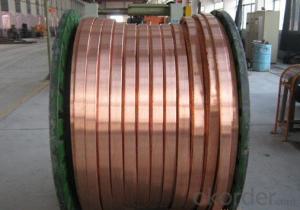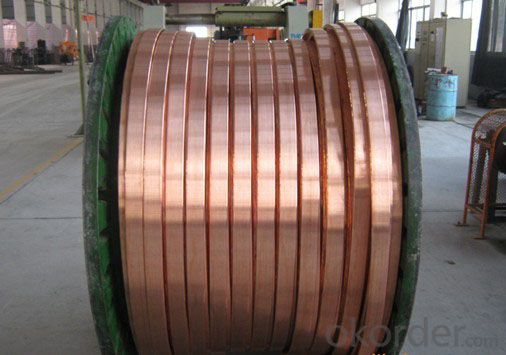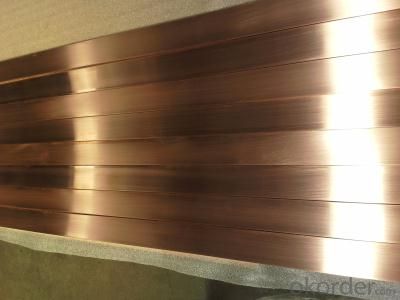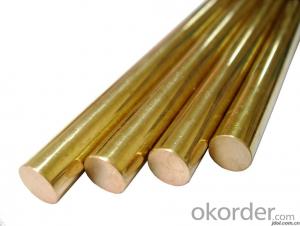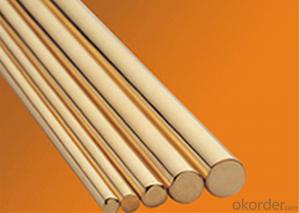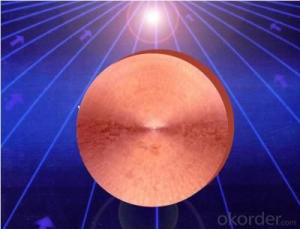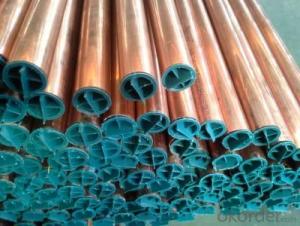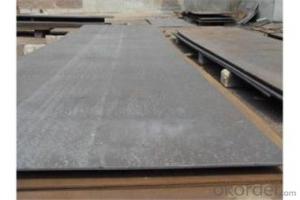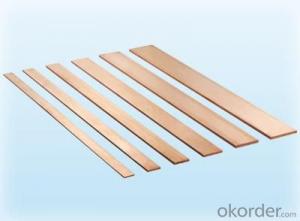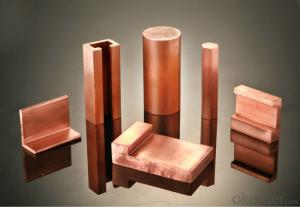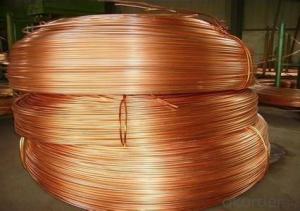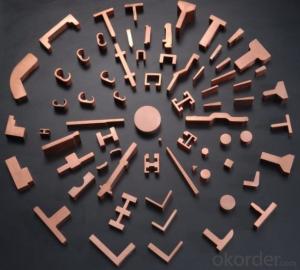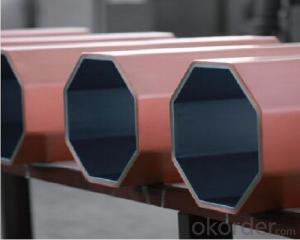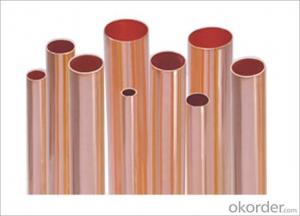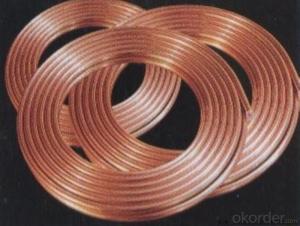Oxygen-free Copper Busbar With High Conductivity
- Loading Port:
- Shanghai
- Payment Terms:
- TT OR LC
- Min Order Qty:
- 500 kg
- Supply Capability:
- 10000 kg/month
OKorder Service Pledge
OKorder Financial Service
You Might Also Like
Product: Oxygen-free copper busbar and copper bar with high conductivity
Brand: Flying Wheel
Type Specifications: T2, TU1, TU2, TAg
Copper busbar is a strip or bar of copper that conducts electricity, often produced with high purity oxygen-free copper ingot through extrusion and drawing processes, usually used in high and low voltage electrical equipment, switch contact, electrical distribution equipment, and bus slot, etc.
Oxygen-free copper busbar and copper bar with high conductivity Specifications
Type | Cu%(WT) | W%(WT) | RWMA | Density | E-conductivity(Min) | heat conduction | thermal expensivity | |
Class | (Min) | Hardness | ((W/mK)) | |||||
(Min) | ||||||||
CuW55 | 45±2 | Balance | 10 | 12.30g/cm3 | 49%IACS | 125HB | ~260 | ~11.7(10-6/K) |
CuW60 | 40±2 | Balance | 12.75g/cm3 | 47%IACS | 140HB | |||
CuW65 | 35±2 | Balance | 3.30g/cm3 | 44%IACS | 155HB | |||
CuW70 | 30±2 | Balance | 13.80g/cm3 | 42%IACS | 175HB | ~240 | ~9.7(10-6/K) | |
CuW75 | 25±2 | Balance | 11 | 14.50g/cm3 | 38%IACS | 195HB | 200~230 | 9.0~9.5 (10-6/K) |
CuW80 | 20±2 | Balance | 12 | 15.15g/cm3 | 34%IACS | 220HB | 190~210 | 8.0~8.5 (10-6/K) |
CuW85 | 15±2 | Balance | 15.90g/cm3 | 30%IACS | 240HB | 180~200 | 7.0~7.5(10-6/K) |
Application: Copper busbar is a strip or bar of copper that conducts electricity, often produced with high purity oxygen-free copper ingot through extrusion and drawing processes, usually used in high and low voltage electrical equipment, switch contact, electrical distribution equipment, and bus slot, etc.
Production Equipment
750-1500kg main frequency induction copper melting furnace, 80MN water seal extruder, LG60 high speed two-roll cold pilger mill, straight-line wire-drawing machine, copper tube/pipe straightener, polisher, 84′ copper coil winding machine, straightening-cutting & pancake coiling machine, thermoplastic packaging machine, 1.2T continuous bright annealing furnace.

80MN extruder

Continuous bright annealing furnace
Testing Devices
spectrum analyzer, atomic absorption analyzer, spectrophotometry, analytical balances, metallurgical microscope, eddy current flaw detector, metal tensile testing machine, eddy conductivity instrument.

Hardness tester

Spectrum analyzer

Metallurgical microscope

Metal tensile testing machine

Atomic absorption analyzer
Process
refined copper — smelting & casting — extrusion — rolling — drawing — straightening-cutting/forming of pancake coil — bright annealing — packaging — finished goods.
Standards
GB/T 1527-2006 Drawn tube of copper and copper alloys
GB/T 16866-2006 Dimensions and tolerances of copper and copper alloy seamless tubes
GB/T 4423-2007 Copper and copper-alloy cold-drawn rod and bar
GB/T 5231-2001 Wrought copper and copper alloys chemical composition limits and forms of wrought products
GB/T 5585.1-2005 Copper or aluminium and its alloy bus bars for electrical purposes—Part 1:Copper andcopper alloy bus bars
GB/T 17791-2007 Seamless copper tube for air conditioner and refrigeration equipment
GB/T 19850-2005 The seamless round copper tubes for electrical purposes
GB/T 26024-2010 Seamless copper and copper alloys tube for valves on air-conditioning and refrigeration system
ASTM B280-2008 Standard Specification for Seamless Copper Tube for Air Conditioning and Refrigeration Field Service
EN 12735-1:2001 Copper and copper alloys Seamless,round copper tubes for air-conditioning and refrigeration Part 1:Tubes for piping systems
EN 12735-2:2001 Copper and copper alloy – seamless round copper tube/pipe for air-conditioning and refrigeration system – for equipment
JIS H3300-2009 Seamless copper and copper alloy tube/pipe
- Q: We have been told that we need to replace our buried copper pipe from our propane tank to our house with black iron pipe because buried copper is no longer in code. How do I find out what is right and what is wrong?
- these are all reasonable and they are concerned about your safety; however the tank will not freeze, do not run the copper into the fireplace box, use black 3/8 or 1/2. the copper will melt or distort in time with the intense heat but black won't, plus you install under the flame rather than above. use it as a fire starter assist or mood low-lite flame. the little tank is not meant for large flame fireplaces and will empty in short time. not cost effective! as for the underground, do 18 after leaving the tank to the outside of the FP, then up the wall to the exposed 1/2 black pipe and join w/ petcock. remember if you have a bush around the fireplace somewhere, you needn't bury the line, place the tank there and a short-run to the petcock. additionally, place in a spray btl a small amt of dish soap and equal amts of wtr. spray this on the lines joints for leaks and if it bubbles.fix it. you're not afraid to cook on your BBQ and the flames on the top and the tank does not explode. so don't worry, this is done all the time and you have a layer of bricks and mortar between the tank and the flame. furthermore, use a carbide drill the size of the pipe to drill into the brick wall then seal with a seal recommended for your area. do a small pilot hole 1st like 1/4 then follow with 1/2 to fit.
- Q: I was able to take a section that I soldered and wiggle the pipe until it became undone. Isnt a properly solderered pipe supposed to be pretty sturdy ay the joint?
- You move the heat across the joint while touching the joint with solder. Then you will know when the pipe is at a temperature to allow the solder to run. then remove the heat, and apply solder around the joint and it will run into the joint. When you clean the pipe before soldering, do not touch the cleaned area until you have applied flux. To test the pipework, turn the water back on slowly, and check for leaks. if it seems okay, then turn the water on more, and check again.
- Q: I know the price of copper has spiked. Has any mining operations resumed in the Keewanaw penisula due to this price rise?
- with copper and other precious metals prices on the rise i expect to see many abandoned copper mines to be revived as long as prices stay where they are or higher. i believe the break even price of copper is 50 to 60 cents a pound.
- Q: I have a heating system using heating elements that use 15mm pipes. The 15mm copper pipes were sweated into control units that were supposed to enable each heater unit to control the volume of water flow / heat generated. The control units were connected to standard 1/2 copper pipes using compression fittings. Over time, all of the plastic control knobs broke off as the pastic became brittle from the heat. The compression fittings on the contols are now leaking as well. I would like to eliminate the control entirely. If I could find something to join the two pipes directly, the whole system would be better offf.
- Hi, we have 22mm under floor in bathroom from the immersion heater, then it changes to 15mm to the taps, cannot say we have had any problems. The shower is 15mm pipes from the mains, that gives a more direct pressure. Any help?
- Q: I did attach the (i hope) water line.
- You could use a two way splitter with compression fittings. Requires no sweating, only a wrench and pipe cutter 1/2 x1/2x 1/4 depending on where you attach it. if you use replace an existing valve it will probably be 1/2 x 1/2 x 3/8 x 1/4. If the existing valve is already compression fitted this will be a simple job. What ever you do , dont over tighten. You can always go back to tighten more, but if you over tighten, you may be meeting a new friend. The Plumber.
- Q: best way to seal off an open water pipe?
- get a blowtorch, a end cap, soldering flux and soldering wire. you start by adding the flux to the end of the open pipe, put the end cap on and over the end of the pipe and heat the end cap and the connecting point a little, a couple of seconds at most, then touch the wire on and around the whole connection with the blow torch on low and running at the connection point and the solder should melt and be sucked into the connection crack by back pressure and by the flux, and your done, test the seal so you know it won't leak at all and if it does, pull the end cap off and try again when the pipe is dry.
- Q: How can the air conditioner copper pipe burst?
- The copper pipe is broken. It is replaced directly, and the refrigerant is filled again.
Send your message to us
Oxygen-free Copper Busbar With High Conductivity
- Loading Port:
- Shanghai
- Payment Terms:
- TT OR LC
- Min Order Qty:
- 500 kg
- Supply Capability:
- 10000 kg/month
OKorder Service Pledge
OKorder Financial Service
Similar products
Hot products
Hot Searches
Related keywords
